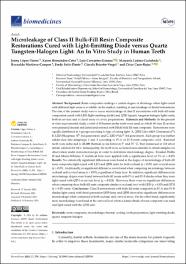Mostrar el registro sencillo del ítem
Microleakage of Class II Bulk-Fill Resin Composite Restorations Cured with Light-Emitting Diode versus Quartz Tungsten-Halogen Light: An In Vitro Study in Human Teeth
| dc.contributor.author | López-Torres, Jenny | |
| dc.contributor.author | Hernández-Caba, Karen | |
| dc.contributor.author | Cervantes-Ganoza, Luis | |
| dc.contributor.author | Ladera-Castañeda, Marysela | |
| dc.contributor.author | Martínez-Campos, Reynaldo | |
| dc.contributor.author | Solís-Dante, Fredy | |
| dc.contributor.author | Briceño-Vergel, Gissela | |
| dc.contributor.author | Cayo Rojas, César | |
| dc.date.accessioned | 2023-04-21T20:00:18Z | |
| dc.date.available | 2023-04-21T20:00:18Z | |
| dc.date.issued | 2023-02-14 | |
| dc.identifier.uri | https://hdl.handle.net/20.500.14308/4652 | |
| dc.description.abstract | Background: Resin composites undergo a certain degree of shrinkage when light-cured with different light sources available on the market, resulting in microleakage of dental restorations. The aim of the present study was to assess microleakage of class II restorations with bulk-fill resin composites cured with LED (light-emitting diode) and QTH (quartz tungsten-halogen light) units, both in cervical and occlusal areas of cavity preparations. Materials and Methods: In the present in vitro experimental study, a total of 30 human molar teeth were used, in which 60 class II cavities were prepared (mesial and distal) and restored with Filtek bulk fill resin composite. Restorations were equally distributed in 3 groups according to type of curing light: A, QTH (Litex 680A Dentamerica®); B, LED (Bluephase N® 3rd generation); and C, LED (Valo® 3rd generation). Each group was further subdivided into subgroups 1 and 2 according to IV-A or IV-B resin composite color. Restored teeth were subjected to 20,000 thermal cycles between 5◦ and 55 ◦C, then immersed in 1M silver nitrate solution for 24 h. Subsequently, the teeth were sectioned mesiodistally to obtain samples for observation under stereomicroscope in order to determine microleakage degree. Kruskal–Wallis H and Mann–Whitney U statistical tests were applied with a significance level of 5% (p < 0.05). Results: No statistically significant differences were found in the degree of microleakage of bulk-fill resin composites light-cured with LED and QTH units for both occlusal (p > 0.05) and cervical areas (p > 0.05). Additionally, no significant differences were found when comparing microleakage between occlusal and cervical areas (p > 0.05), regardless of lamp type. In addition, significant differences in microleakage degree were found between bulk-fill resins with IV-A and IV-B shades when they were light-cured with QTH at cervical level (p = 0.023). However, there were no significant differences when comparing these bulk-fill resin composite shades at occlusal level with LED (p > 0.05) and QTH (p > 0.05) units. Conclusions: Class II restorations with bulk-fill resin composite in IV-A and IV-B shades light-cured with third generation LED lamp and QTH showed no significant differences in microleakage when compared in both occlusal and cervical areas. On the other hand, significantly more microleakage was found at the cervical level when a darker shade of resin composite was used and light-cured with the QTH unit | es_PE |
| dc.format | application/pdf | es_PE |
| dc.language.iso | eng | es_PE |
| dc.publisher | Biomedicines | es_PE |
| dc.rights | info:eu-repo/semantics/openAccess | es_PE |
| dc.rights.uri | https://creativecommons.org/licenses/by/4.0/ | es_PE |
| dc.subject | Compuesto de resina | es_PE |
| dc.subject | Microfiltración | es_PE |
| dc.subject | Ciclos térmicos | es_PE |
| dc.subject | Preparación de dientes | es_PE |
| dc.subject | Diodo emisor de luz | es_PE |
| dc.subject | Cuarzo tungsteno-halógeno | es_PE |
| dc.title | Microleakage of Class II Bulk-Fill Resin Composite Restorations Cured with Light-Emitting Diode versus Quartz Tungsten-Halogen Light: An In Vitro Study in Human Teeth | es_PE |
| dc.type | info:eu-repo/semantics/article | es_PE |
| dc.subject.ocde | https://purl.org/pe-repo/ocde/ford#3.02.14 | es_PE |
| dc.publisher.country | CH | es_PE |
| dc.identifier.doi | https://doi.org/10.3390/biomedicines11020556 |


